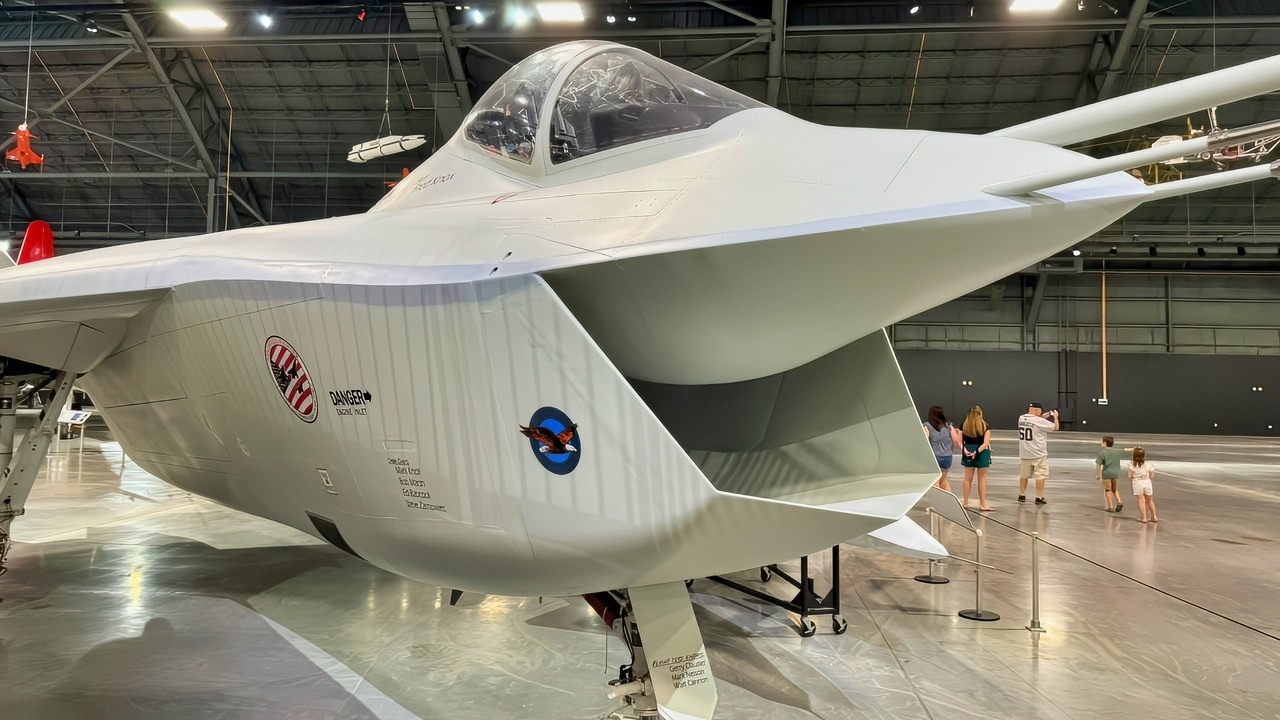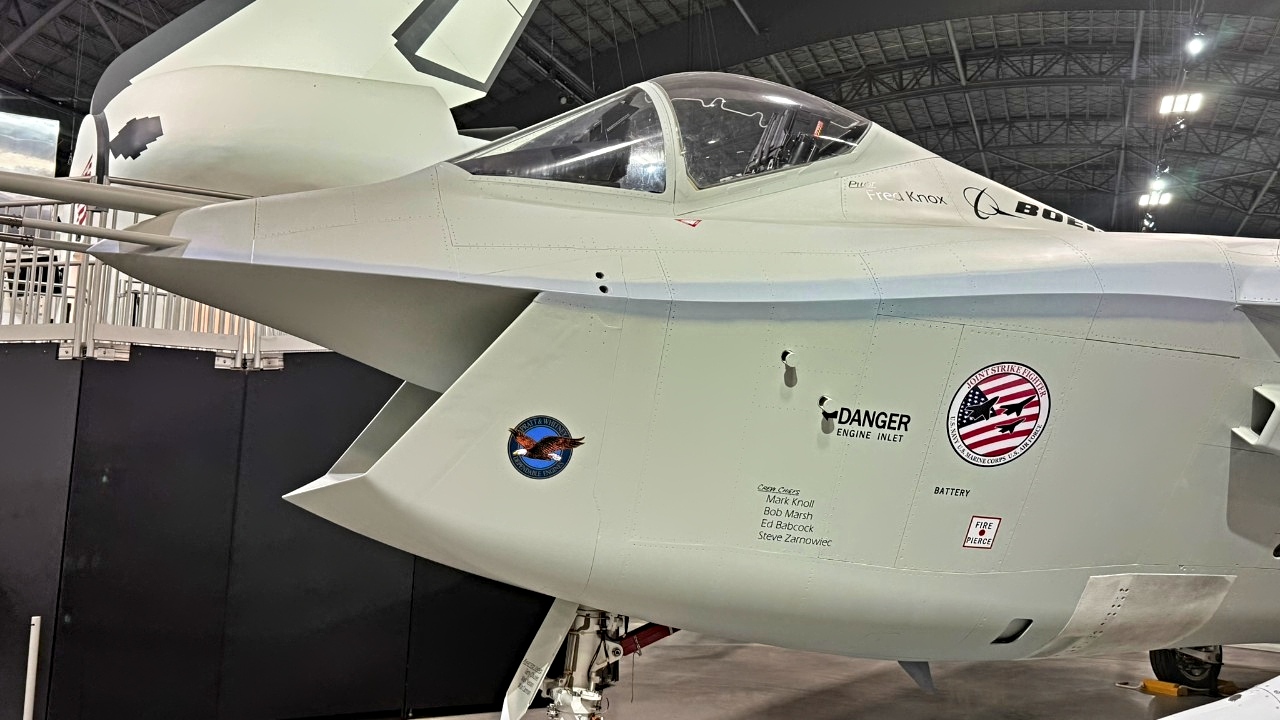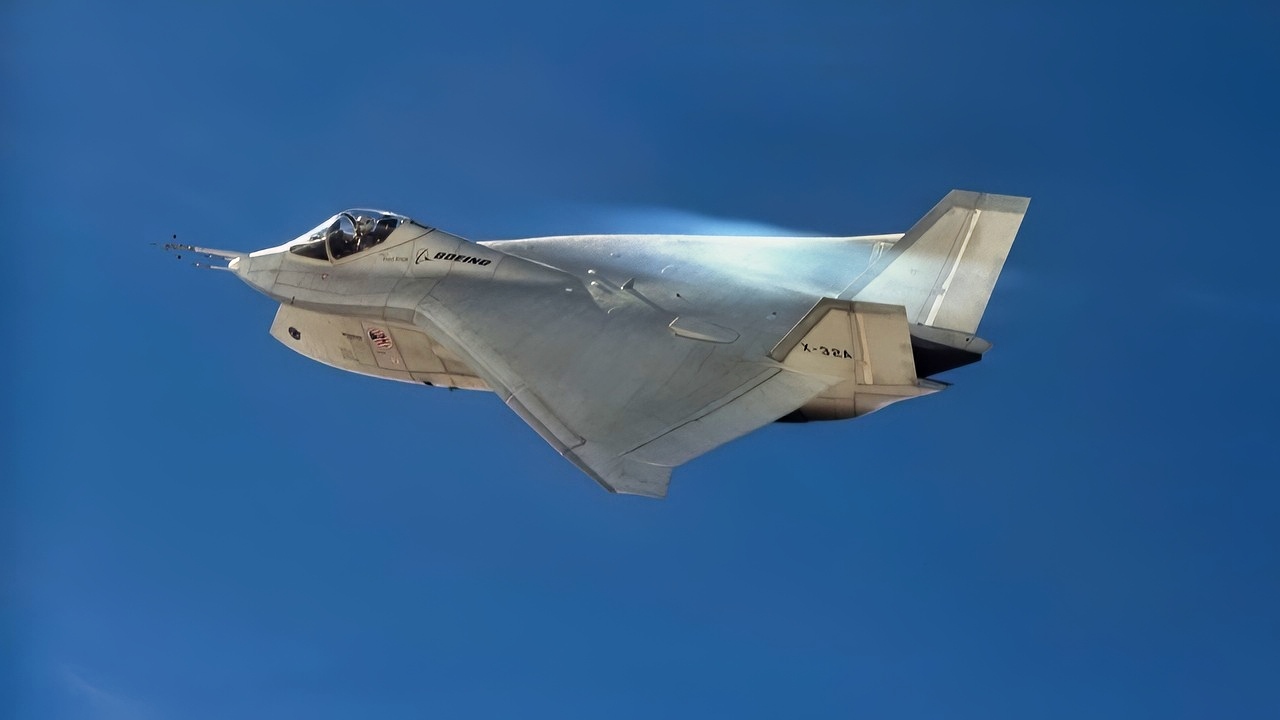Key Points and Summary – The Boeing X-32 had one mission: beat the X-35 (what we know as the F-35 today). And yet, it had no chance for many reasons.
-Beyond its ungainly appearance, Boeing’s X-32 lost the Joint Strike Fighter competition due to critical technical failures and a less adaptable design.
-A primary reason was its inability to demonstrate a mature vertical landing (STOVL) capability, a key Marine Corps requirement that its rival, the X-35, successfully performed.
-Furthermore, the X-32’s one-piece wing design was seen as less flexible and “future-proof” than the X-35’s modular approach.
-Ultimately, the Pentagon chose Lockheed Martin’s design as the more capable, mature, and lower-risk option to become the F-35.
The Boeing X-32 Fighter Question
The Boeing X-32, an experimental stealth fighter jet built by Boeing as part of the Joint Strike Fighter competition, ultimately lost to Lockheed Martin’s X-35.
The reasons for the X-32’s JSF competition loss are numerous, but involved several technical and operational factors.
Vertical Take-off and Landing
Compared to the X-35, which would ultimately go on to become today’s F-35 fighter, the X-32’s solution for vertical landing, a requirement for the U.S. Marine Corps, proved to be one of the most difficult aspects of that fighter’s development.
The design fielded by Boeing in their X-32 used a direct-lift system not dissimilar to that leveraged by the Harrier jump jet to quickly boost into the air and gently land back on the ground.
Direct-lift systems on fighter jets are a proven and tested technology.
However, Boeing decided to change their approach during the middle of the X-32 design program, opting instead for a shaft-driven lift fan. Ultimately, the X-32 was unable to demonstrate a full STOVL capability. The X-35, on the other hand, could.

Boeing X-32 Fighter at USAF Museum July 2025. Image Credit: National Security Journal.

Boeing X-32 Near Space Shuttle. Image Credit: National Security Journal.
Indeed, the X-35’s lift fan system, developed in collaboration with aerospace giant Rolls-Royce, proved to be a more effective and efficient fan design, one that demonstrated an accurate vertical take-off and landing capability more mature than the offering by Boeing.
A Compromised Design?
The Joint Strike Fighter program aimed to build a single platform, with three core variants that could all cater to the needs of the United States Air Force, Navy, and Marine Corps. Although the three F-35 variants, A, B, and C, respectively, achieved the balance of requirements to ultimately become a viable platform for all three services, the X-32 struggled to meet each branch’s JSF requirements.
The X-32’s delta-wing design and large single-inlet air intake were optimized for carrier approaches and landings, while also maximizing internal weapon bay volume.
However, the trade-off was limited maneuverability and lower aerodynamic performance compared to the X-35, though the protoype jet did come in two variants, the X-32A and X-32B, which the National Museum of the United States Air Force explains that “together performed Conventional Take-Off and Landings (CTOL), Short Take-Off and Vertical Landings (STOVL), and as a Carrier Variant (CV).
Compared to the X-35, which had slightly different wing sizes and shapes among the three variants, the X-32 relied instead on a single, one-piece fuselage and wing, which limited that plane’s potential for future modifications or design tweaks.
Additionally, the U.S. Navy’s assessment of the X-32 and X-35’s suitability for operations from U.S. Navy carriers favored Lockheed Martin’s prototype over that of Boeing.
Risk Assessment: Costs vs Benefits
At the time of the Joint Strike Fighter competition, the Pentagon sought a single platform that could strike a viable balance between performance and cost, while also retaining flexibility for future design changes and adaptations in response to emerging threats and technologies.
The X-35 from Lockheed struck that balance better than the X-32. Not only did the X-35 appear more conventionally like a stealth fighter, it also offered a greater deal of flexibility as well as bringing lower risk into the Joint Strike Fighter project.
In addition, the X-35 could, at the time of the JSF competition, clearly demonstrate a mature STOVL capacity, while Boeing’s design could not.
The Politics of Perception
Performance statistics and future capabilities aside, one potential edge that the F-35 retains today over the X-32 prototype fighter is that it simply looks more like a modern, fifth-generation stealth fighter.
Aesthetics should, on paper, not matter much at all.
However, procurement decisions are influenced by the U.S. Congress, defense firms, their partners, and the individual service branches.
In this context, any edge — even one that is purely visual — counts. Compared to the X-32, which, by comparison, is a rather ungainly aircraft, it did not immediately inspire the same degree of confidence that the X-35 did.
The X-32 Is Stuck in Museum Duty
Ultimately, the X-35 demonstrated a clear advantage in capabilities compared to Boeing’s X-32, particularly in a much more mature STOVL capability that gave it a distinct edge. In addition, the X-35 was a more modular and “future-proof” design that could adapt to future needs and incorporate new technologies more seamlessly than the X-32.
It was also, put rather simply, the better-looking of the two fifth-generation prototype fighter jets, and one that managed to strike a remarkable balance between risk and function. For these reasons, the Pentagon ultimately chose Lockheed Martin’s design in 2001.
About the Author: Caleb Larson
Caleb Larson is an American multiformat journalist based in Berlin, Germany. His work covers the intersection of conflict and society, focusing on American foreign policy and European security. He has reported from Germany, Russia, and the United States. Most recently, he covered the war in Ukraine, reporting extensively on the war’s shifting battle lines from Donbas and writing on the war’s civilian and humanitarian toll. Previously, he worked as a Defense Reporter for POLITICO Europe. You can follow his latest work on X.
More Military
M551 Sheridan Light Tank Has a Message for the U.S. Army
M10 Booker: The Army’s Light Tank Disaster
The U.S. Navy’s Constellation-Class Frigate: Is It Beyond Saving?
Boeing’s F-47 NGAD: Soon To Get Injection of Ferrari F-35 DNA?










